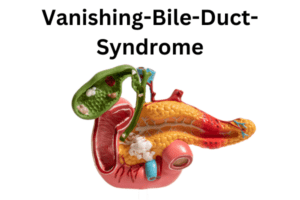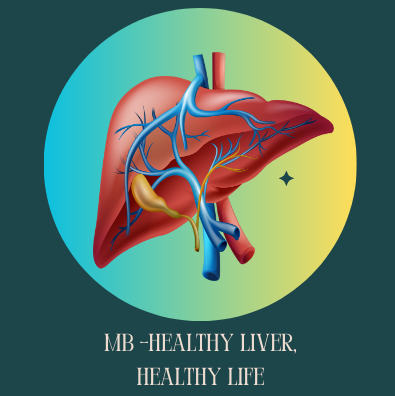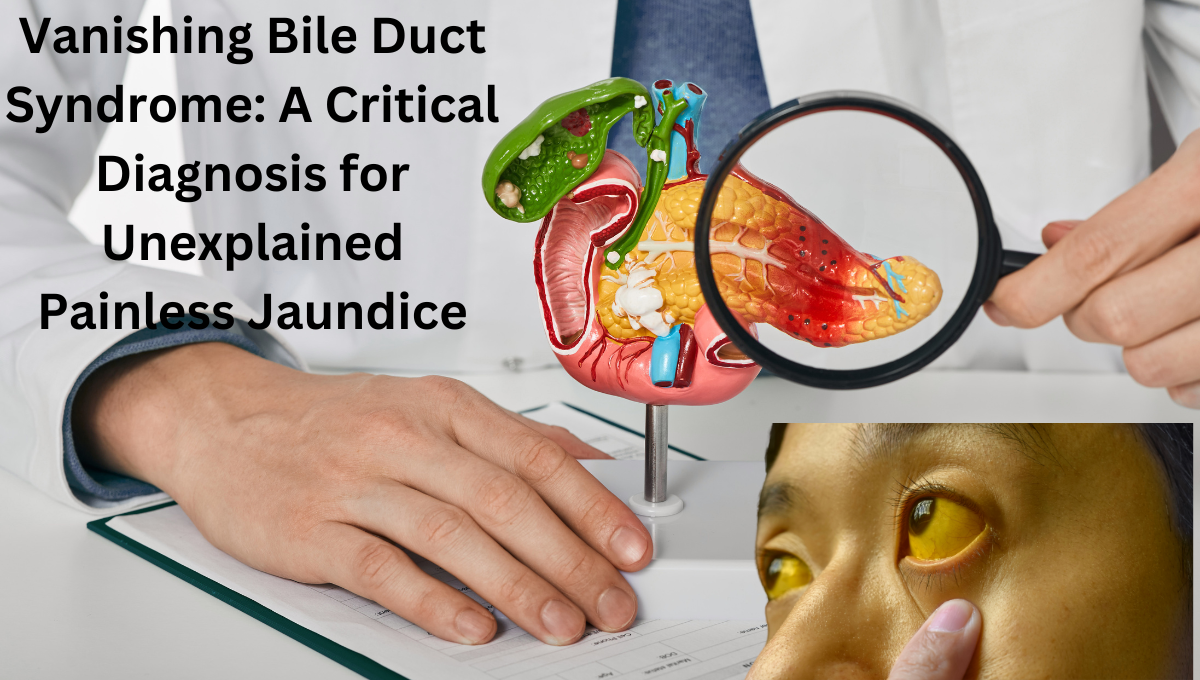Vanishing Bile Duct Syndrome: A Critical Diagnosis for Unexplained Painless Jaundice
Vanishing Bile Duct Syndrome
Overview
The main symptom of the uncommon and frequently mysterious Vanishing Bile Duct Syndrome (VBDS) is painless jaundice, devoid of the usual warning indicators that would indicate serious liver failure. The progressive loss of bile ducts, which causes cholestasis, liver dysfunction, and, frequently, chronic liver failure, is what characterizes it. Due to its mild clinical appearance, VBDS is frequently misdiagnosed until irreparable liver damage has occurred, making diagnosis challenging.
Healthcare professionals must be aware of the causes, clinical manifestations, diagnostic techniques, and treatment plans for VBDS. Early diagnosis and treatment can stop the disease from getting worse, improve patient outcomes, and slow the degradation of the liver.
Vanishing Bile Duct Syndrome: What Is It?
 The progressive deterioration or removal of the intrahepatic bile ducts—the microscopic tubes that carry bile from the liver to the intestines—denotes Vanishing Bile Duct Syndrome, a cholestatic liver condition. The syndrome results in cholestasis, a disorder that causes the flow of bile to be restricted or obstructed, leading to an accumulation of bile acids in the blood and liver. Liver failure, cirrhosis, and fibrosis may develop from this over time.
The progressive deterioration or removal of the intrahepatic bile ducts—the microscopic tubes that carry bile from the liver to the intestines—denotes Vanishing Bile Duct Syndrome, a cholestatic liver condition. The syndrome results in cholestasis, a disorder that causes the flow of bile to be restricted or obstructed, leading to an accumulation of bile acids in the blood and liver. Liver failure, cirrhosis, and fibrosis may develop from this over time.
VBDS presents unique challenges due to its ambiguous symptoms and gradual progression. Although VBDS usually presents as painless jaundice, it is often misdiagnosed in its early stages due to the fact that many liver disorders show with pain, fever, or overt indications of liver malfunction.
Vanishing Bile Duct Syndrome: Factors at Risk and Causes of VBDS
Numerous underlying disorders, each of which contributes differently to the death of bile ducts, can cause Vanishing Bile Duct Syndrome. Viral infections, autoimmune disorders, medication toxicity, and graft-versus-host disease (GVHD) are a few of the most frequent causes. Here’s a thorough examination of each:
1. Vanishing Bile Duct Syndrome: A Critical Diagnosis for Unexplained Painless Jaundice Induced by Drugs
One of the most commonly found causes of VBDS is drug poisoning. Antibiotics, anti-inflammatory medicines, and immunosuppressants in particular are linked to cholestatic liver injury, which can result in the loss of the bile ducts. One popular antibiotic that has been specifically connected to medication-induced cholestasis is amoxicillin-clavulanate. NSAIDs, antipsychotics, and sulfonamides are among the other medications that have also been connected.
Restarting the offending medication may stop the course of bile duct loss in cases of drug-induced VBDS, but damage done up until that point is frequently irreparable.
2. Immune Conditions
Bile duct damage can also result from autoimmune illnesses such primary sclerosing cholangitis (PSC) and primary biliary cholangitis (PBC). Under these circumstances, the bile ducts are unintentionally attacked by the immune system, which leads to inflammation and eventual bile duct loss. Early management is essential to halting the progression of these autoimmune disorders because they are chronic and frequently worsen over time.
Vanishing Bile Duct Syndrome can also result from immune-mediated liver disease called autoimmune hepatitis, especially in its advanced stages when bile duct destruction is more noticeable.
3. Infections with viruses
A number of viral infections have been linked to VBDS development and liver damage. Bile duct epithelial cells can be destroyed by immune-mediated means by viruses such as the hepatitis B and C viruses, cytomegalovirus, and Epstein-Barr virus (EBV). Particularly in people with impaired immune systems, the presence of these viruses causes an inflammatory response that eventually results in the loss of bile ducts.
4. Disease of the Graft Versus Host (GVHD)
Graft-versus-host disease (GVHD) puts patients undergoing bone marrow transplantation at high risk of acquiring VBDS. The immune system of the donor targets the recipient’s tissues, particularly the bile ducts, in GVHD. Liver failure eventually results from cholestasis, bile duct loss, and immune-mediated damage. Treatment for GVHD-induced VBDS is more difficult, and immunosuppressive medication is frequently needed to regulate the immune response.
5. Genetic Disorders
Bile duct paucity can also be caused by the rare genetic condition Alagille syndrome, which can mirror the presentation of VBDS. Mutations in the JAG1 or NOTCH2 genes, which are essential for the formation of the bile duct, cause this genetic disorder. In infancy or early childhood, patients with Alagille syndrome frequently show with jaundice, pruritus, and cholestasis.
Clinical Presentation: Painless Jaundice’s defining feature
The most prevalent and indicative sign of Vanishing Bile Duct Syndrome is painless jaundice. When VBDS-related jaundice occurs, patients do not typically experience fever or severe abdominal pain, unlike obstructive jaundice brought on by gallstones or tumors. Since the patient could put off seeking medical attention until the jaundice becomes clearly noticeable or other issues occur, this lack of pain might cause a delay in diagnosis and action.
Patients with VBDS may also experience painless jaundice and the following symptoms:
Itching or pruritus: brought on by bile acid buildup in the blood.
As the liver’s capacity to digest nutrients and detoxify the body is compromised, fatigue is a prevalent symptom of the majority of liver illnesses.
Urine turns dark due to the excretion of increased bilirubin when blood bilirubin levels rise.
Pale stools: Bile output into the intestines is reduced when bile flow is impaired, resulting in stools that are pale or clay-colored.
Unexpected weight loss: Frequently a sign of deteriorating liver disease and dietary malabsorption.
When VBDS reaches late stages, it can cause consequences such coagulopathy (increased bleeding tendency owing to reduced synthesis of clotting proteins), hepatic encephalopathy (mental confusion due to the liver’s failure to detoxify the blood), and ascites (fluid accumulation in the abdomen).
Vanishing Bile Duct Syndrome Diagnosis
A combination of laboratory testing, liver biopsy, and clinical evaluation is needed to diagnose VBDS. It takes an early and precise diagnosis to stop irreparable liver damage.
1. Assessment of Clinical
VBDS is diagnosed initially by a comprehensive clinical history and physical examination. Doctors should be on the lookout for liver dysfunction symptoms such as pruritus and jaundice. It is important to ask patients about their medical history, particularly any exposure to hepatotoxic substances, autoimmune conditions they may have had in the past, and any recent viral infections.
2. Exams in the lab
Laboratory testing usually show abnormal liver function tests (LFTs) and high bilirubin levels, which indicate impaired bile flow. More specifically, cholestatic liver illnesses such as VBDS are frequently associated with higher levels of alkaline phosphatase (ALP) and gamma-glutamyl transferase (GGT). However, because these markers are nonspecific, more research is necessary to validate the diagnosis.
3. Hepatic Biopsy
The most reliable method for diagnosing VBDS is a liver biopsy. The feature of the syndrome is the absence or destruction of intrahepatic bile ducts, which will be revealed by the biopsy. The diagnosis is verified by the removal of more than 50% of the bile ducts. Depending on the disease’s underlying origin, further histological abnormalities such portal inflammation or fibrosis may occasionally be seen.
Vanishing Bile Duct Syndrome Management and Treatment
The underlying cause of Vanishing Bile Duct Syndrome largely determines how to treat it. The main objective of treatment is to stop the bile duct loss from getting worse and stop more liver damage from happening.
1. Stopping Drug Use
The offending substance must be stopped right away in cases of drug-induced VBDS. Even though quitting the medication might not repair the damage to the bile ducts, it can halt the illness from getting worse.
2. Treatment for Immunosuppression
Patients with GVHD or autoimmune-mediated VBDS frequently require immunosuppressive medication. In addition to other immunosuppressants, corticosteroids may help lessen the immunological response to the bile ducts and delay the course of the disease.
3. Helping Others
An important aspect of treating VBDS is managing symptoms. For instance, cholestyramine or rifampicin may be administered to treat the severe itching brought on by the accumulation of bile acid. Patients suffering from cholestasis are susceptible to malnourishment and vitamin deficiencies; therefore, nutritional care and supplementation are also crucial (especially for fat-soluble vitamins A, D, E, and K).
4. Transplanting livers
In severe situations where there is a marked decline in liver function, liver transplantation might be the only effective treatment. Transplantation, however, is usually saved for situations in which liver failure is rapidly approaching and all other therapies have failed.
In summary
Painless jaundice can be caused by the uncommon and frequently misdiagnosed Vanishing Bile Duct Syndrome. Because of its mild presentation, early diagnosis and intervention are essential to preventing irreparable liver damage, although they can be difficult to achieve. Healthcare professionals can identify patients promptly and treat patients with tailored care to stop the progression of the disease and enhance patient outcomes by understanding the risk factors, symptoms, and diagnostic criteria.
 https://analytics.google.com/analytics/web/#/analysis/p405220706
Skip to content
https://analytics.google.com/analytics/web/#/analysis/p405220706
Skip to content 
